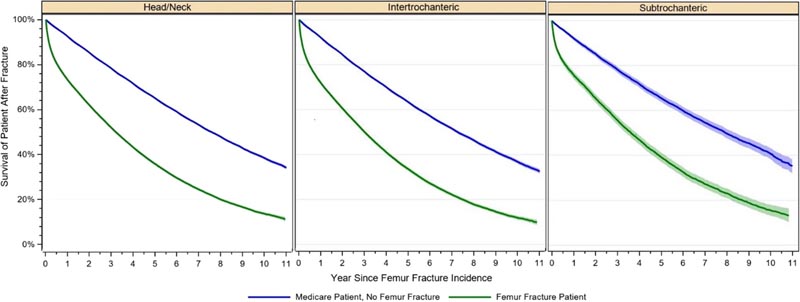Proximal femoral fractures are one of the most common fractures. Projections anticipate a prevalence of up to 21.3 million cases annually worldwide by 2050. Particularly for elderly patients, these types of fractures are associated with serious complications. The aim of our study was to investigate the mortality rate and influencing factors of all types of proximal femoral fractures.
Aim
Proximal femoral fractures are a serious complication, especially in elderly patients. Therefore, we have set out to answer the following research question: What is the post-fracture mortality rate in the elderly population and what are the associated risk factors?
Methods
For this, proximal femoral fractures that occurred between January 1, 2009 and December 31, 2019 were identified from the Medicare medical records database.
The Kaplan-Meier (KM) method with adaptation of the Fine and Gray subdistribution was used to determine mortality rates. A semiparametric Cox regression model was applied, incorporating 23 measures as covariates to identify risk factors.
Results
The estimated 1-year mortality rate was 26.8% after a head/neck fracture, 28.2% after an intertrochanteric fracture, and 24.2% after a subtrochanteric fracture.
Male sex, age over 70 years, chronic obstructive pulmonary disease (COPD), cerebrovascular disease, chronic kidney disease, concomitant fracture, congestive heart failure, diabetes mellitus, hypertension, insulin use, ischemic heart disease, morbid obesity, osteoporosis, smoking, and median family income were determined as risk factors for increased mortality.
An early evaluation of individual risk factors accessible for therapeutic treatment is crucial in the management of proximal femur fractures to assist in attempts to reduce the high mortality apparent in the elderly US population and the average family income. were determined as risk factors for increased mortality.

Figure : Patient survival after a proximal femur fracture compared to other Medicare enrollees without a femur fracture.
Discussion
The estimated 1-year mortality rate of 26.8% after a head/neck fracture, 28.2% after an intertrochanteric fracture, and 24.2% after a subtrochanteric fracture is consistent with the literature, with other reports reporting rates of 21.2%, 23.0%, 20.7%, and 18.8%, respectively, for proximal femur fractures in the elderly.
Male sex, age over 70 years, chronic obstructive pulmonary disease (COPD), cerebrovascular disease, chronic kidney disease, concomitant fracture, congestive heart failure, diabetes mellitus, arterial hypertension, insulin use, ischemic heart disease, morbid obesity, osteoporosis, smoking , and median family income were determined as risk factors for increased mortality.
Other investigations confirmed these results and also reported an increased risk of mortality associated with a low Parker mobility score (OR = 2.94, 95% CI: 1.31–6.57, p = 0.01), a Charlson comorbidity score of 4 or more (OR = 2.15, 95% CI 1.30–3.55, p = 0.002) [2], as well as in patients affected by more than two comorbidities (respectively OR 30 days = 2.003, OR 6 months = 1.8654, and OR 1 year = 1.5965) [ 5 ].
In a meta-analysis of 18 cohort studies published by Liu et al. (2018), most of the identified risk factors were verified, while in this analysis male sex was reported as an influential factor (HR 1.91, p < 0.001) more than female sex.
Surprisingly, the meta-analysis did not show an increased risk of mortality from diabetes mellitus (HR 1.15, p < 0.121) or nicotine use (HR 1.54, p < 0.337).
Conclusion In this case-control study , high mortality from proximal femur fractures was evident in the elderly US population. An early assessment of individual risk factors accessible for therapeutic treatment is crucial in the management of femur fractures. proximal femur to assist in attempts to reduce mortality. |















